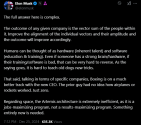There is massive sunk cost associated with acquiring tooling and infrastructure for their current design: 9m diameter (10+ is better for all sorts of reasons), that unorthodox upper stage, among other things.
Best to just press on. I think eventually the vehicle will work.
Blue Origin's Blue Moon lander acts as bit of a hedge. It is a more conventional design but still uses unproven orbital refueling of cryo fuels.
Elon doesn't really care about the Starship HLS contract. Worst comes to worst he gets a slap on the wrist for failing a government contract. The vehicle is clearly built as a Starlink deployer, it's not efficient for Artemis.
He's also trying to influence the new Admin to make drastic changes to Artemis
Visually steel and aluminum don't look that different, but if you run the numbers through rocket equation, especially for the upper stage, you'll get a better appreciation of just big a difference 3.3x higher specific strength of 7075 aluminum makes.
You're right they've sunk too much into this design to go back, but the fact that v2 needed to increase upper stage fuel by 25% at expense of payload bay volume (as opposed to stretch which adds more steel), and still can only manage 20 tons suborbital on v1 booster, already demonstrated they're dealing with a set of predictable problems they really don't want to talk about.
Also keep in mind you can't just stack more and more mass without increasing diameter or change fuel, at some point you'll reach the physics limit of engine chamber pressure with a given fuel chemistry. Right now they're basically betting everything on Raptor 3 and Starship v3, and even then I would not be surprised if final performance is not much different than Long March 10, and achieved after Long March 10
As for Blue Orgin, New Glen is a properly engineered rocket, certainly better than Starship, but its LEO lift is half of LM10, and it's GTO / TLI performance is actually lower than LM5, i.e. it wouldn't even be able to launch Chang'e 5 at 8,200 kg to TLI... Yeah they're betting on in-orbit fuel depot too, but counting on it to pull off manned lunar mission is asking a lot.
Now keep in mind China's lunar mission only needs 2x LM10 launches, while every American mission needs at least 5 launches if not close to 20 (if v3 works) for Starship. Right now they're still telling themselves they're ahead because China doesn't say much, but at some point they'll realize they won't make it, then the funding and planning enviroment will become a lot different.
Musk Tweeting they should just go to Mars first could be the begining of that mental shift.

